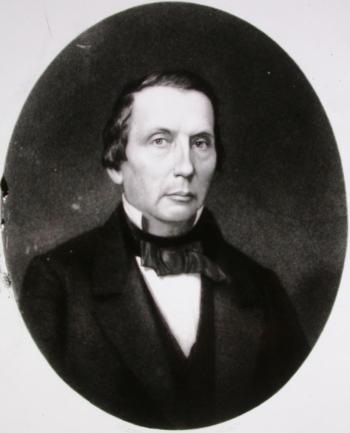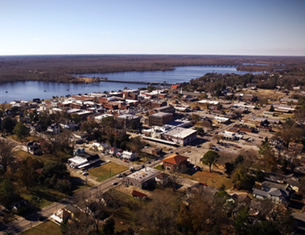A Constitutional Republic, where the First Amendment is Essential to OUR Survival
Constitution of 1835
Publisher's note: We believe the subject of history makes people (i.e., American people) smarter, so in our quest to educate others, we will provide excerpts from the North Carolina History Project, an online publication of the John Locke Foundation. This fortieth installment, by Ronnie W. Faulkner, Campbell University, was originally posted in the North Carolina History Project.
The constitutional revisions of 1835 resulted in great part from North Carolina's acceptance of Jacksonian democracy, a political movement that emphasized participation of the common man in the political process. The democratic movement gained momentum after Andrew Jackson (1767-1845) was elected to the presidency in 1828. There had been years of protest against the Constitution of 1776 with its disproportionate representation of eastern counties, extensive property requirements for voting and office holding, and for its omission of an amendment and an impeachment process.
By the 1830s, demands
 for reform came primarily from three quarters: westerners (at the time primarily from the Piedmont), who wanted equitable geographic representation in the General Assembly; Whig politicians, who disliked Democratic domination of state politics; and economic planners, who wanted to build internal improvements that easterners had prevented. Internal improvements fostered trade by building and improving transportation arteries, draining swampland, and dredging harbors.
for reform came primarily from three quarters: westerners (at the time primarily from the Piedmont), who wanted equitable geographic representation in the General Assembly; Whig politicians, who disliked Democratic domination of state politics; and economic planners, who wanted to build internal improvements that easterners had prevented. Internal improvements fostered trade by building and improving transportation arteries, draining swampland, and dredging harbors.
In 1834, the state legislature narrowly passed the Convention Act; it outlined the responsibilities of the planned constitutional convention. Later that year, the issue was put to a vote of the people and passed 27,550 to 21,694, with most opposition coming from eastern North Carolina.
When the Convention convened in Raleigh on June 4, 1835, geographical representation consisted of seventy-six delegates from eastern counties and fifty-four from western counties. Political party representation was divided among sixty-three Whigs, thirty-eight Democrats, and twenty-nine independents; Governor David L. Swain (1801-1868), a key Convention supporter, was also present. The diverse body of delegates elected statesman Nathaniel Macon (1757-1837) as president.
Sweeping changes were
 adopted. Borough (or individual town) representation was abolished, biennial sessions of the legislature were instituted, the governorship was changed to a two-year elective office, the poll tax (or head tax) was equalized, the word "Protestant" was changed to "Christian" in Article 32 of the old Constitution, the free black vote was eliminated, property requirements for voting and holding office were reduced, an amendment process was adopted, and impeachment provisions were introduced.
adopted. Borough (or individual town) representation was abolished, biennial sessions of the legislature were instituted, the governorship was changed to a two-year elective office, the poll tax (or head tax) was equalized, the word "Protestant" was changed to "Christian" in Article 32 of the old Constitution, the free black vote was eliminated, property requirements for voting and holding office were reduced, an amendment process was adopted, and impeachment provisions were introduced.
William Gaston (1778-1844), lawyer, legislator, congressman, and judge, was the only Roman Catholic delegate to the Convention. Gaston's popularity and character, however, played a key role in persuading fellow delegates to change the religious requirement in Article 32 from "Protestant" to "Christian." Some delegates favored eliminating any religious requirement because, they claimed, it had never been used to exclude anyone from state office.
The convention of 1835 instituted another change. Until that year, "free persons of color" could vote in North Carolina if they met property requirements. The African American vote in the state and the Indian vote in Robeson County were ultimately eliminated by an amazingly close vote of sixty-six to sixty-one. Approximately forty-eight percent of Whigs and forty-five percent of Democrats voted against black disfranchisement.
The most important
 changes, however, involved legislative representation. The lower House of the General Assembly would be based on the federal census; no county would have less than one representative in the 120-member body. To vote for a Representative, one only had to be a taxpayer. District representation in the fifty-member Senate would be based on the amount of taxes paid to the state. To vote for a Senator one had to own fifty acres of property. These changes significantly increased western representation in the House, yet left easterners in control of the Senate.
changes, however, involved legislative representation. The lower House of the General Assembly would be based on the federal census; no county would have less than one representative in the 120-member body. To vote for a Representative, one only had to be a taxpayer. District representation in the fifty-member Senate would be based on the amount of taxes paid to the state. To vote for a Senator one had to own fifty acres of property. These changes significantly increased western representation in the House, yet left easterners in control of the Senate.
These extensive and drastic changes more than doubled the length of the 1776 state constitution. All the changes were made into a single ballot proposition which passed 26,771 to 21,606 on November 9, 1835. In this vote, as in the previous statewide vote, westerners by and large agreed to the changes and easterners did not.
Subsequent elections soon revealed the effects of the Convention's changes. First, despite the regressive act of black disfranchisement, the number of North Carolina voters increased. Second, the two-party system was soon firmly established, but the Whig Party almost immediately dominated Tar Heel politics and successfully promoted such issues as public education and internal improvements; by 1840, party conventions, platforms, extensive campaigns, and the spoils system developed for the first time in North Carolina. Third, direct election had increased the governor's status, although the top executive still lacked veto power. Fourth, the western region gained more political power in state government, while the power of the eastern region declined.
Sources:
John L. Cheney, Jr., ed. North Carolina Government: 1585-1979 (Raleigh, 1981); Henry G. Connor, "Convention of 1835," North Carolina Booklet (October, 1908); Harold J. Counihan, "The North Carolina Constitutional Convention of 1835: A Study in Jacksonian Democracy," North Carolina Historical Review (October, 1969); William S. Powell, North Carolina Through Four Centuries (Chapel Hill, 1989).
Go Back
The constitutional revisions of 1835 resulted in great part from North Carolina's acceptance of Jacksonian democracy, a political movement that emphasized participation of the common man in the political process. The democratic movement gained momentum after Andrew Jackson (1767-1845) was elected to the presidency in 1828. There had been years of protest against the Constitution of 1776 with its disproportionate representation of eastern counties, extensive property requirements for voting and office holding, and for its omission of an amendment and an impeachment process.
By the 1830s, demands

After his 1828 election, President Andrew Jackson, a native North Carolinian, bolstered the democratic movement. Image courtesy of the North Carolina Office of Archives and History, Raleigh, NC.
In 1834, the state legislature narrowly passed the Convention Act; it outlined the responsibilities of the planned constitutional convention. Later that year, the issue was put to a vote of the people and passed 27,550 to 21,694, with most opposition coming from eastern North Carolina.
When the Convention convened in Raleigh on June 4, 1835, geographical representation consisted of seventy-six delegates from eastern counties and fifty-four from western counties. Political party representation was divided among sixty-three Whigs, thirty-eight Democrats, and twenty-nine independents; Governor David L. Swain (1801-1868), a key Convention supporter, was also present. The diverse body of delegates elected statesman Nathaniel Macon (1757-1837) as president.
Sweeping changes were

Governor David L. Swain, a key Constitutional Convention supporter. Image courtesy of the North Carolina Office of Archives and History, Raleigh, NC.
William Gaston (1778-1844), lawyer, legislator, congressman, and judge, was the only Roman Catholic delegate to the Convention. Gaston's popularity and character, however, played a key role in persuading fellow delegates to change the religious requirement in Article 32 from "Protestant" to "Christian." Some delegates favored eliminating any religious requirement because, they claimed, it had never been used to exclude anyone from state office.
The convention of 1835 instituted another change. Until that year, "free persons of color" could vote in North Carolina if they met property requirements. The African American vote in the state and the Indian vote in Robeson County were ultimately eliminated by an amazingly close vote of sixty-six to sixty-one. Approximately forty-eight percent of Whigs and forty-five percent of Democrats voted against black disfranchisement.
The most important

Nathaniel Macon, a well known statesman, was appointed president of the 1835 Constitutional Convention. Image courtesy of the North Carolina Office of Archives and History, Raleigh, NC.
These extensive and drastic changes more than doubled the length of the 1776 state constitution. All the changes were made into a single ballot proposition which passed 26,771 to 21,606 on November 9, 1835. In this vote, as in the previous statewide vote, westerners by and large agreed to the changes and easterners did not.
Subsequent elections soon revealed the effects of the Convention's changes. First, despite the regressive act of black disfranchisement, the number of North Carolina voters increased. Second, the two-party system was soon firmly established, but the Whig Party almost immediately dominated Tar Heel politics and successfully promoted such issues as public education and internal improvements; by 1840, party conventions, platforms, extensive campaigns, and the spoils system developed for the first time in North Carolina. Third, direct election had increased the governor's status, although the top executive still lacked veto power. Fourth, the western region gained more political power in state government, while the power of the eastern region declined.
Sources:
John L. Cheney, Jr., ed. North Carolina Government: 1585-1979 (Raleigh, 1981); Henry G. Connor, "Convention of 1835," North Carolina Booklet (October, 1908); Harold J. Counihan, "The North Carolina Constitutional Convention of 1835: A Study in Jacksonian Democracy," North Carolina Historical Review (October, 1969); William S. Powell, North Carolina Through Four Centuries (Chapel Hill, 1989).
| Dare Medical Associates joins Vidant Medical Group | NC Past, In the Past, Body & Soul | City of Raleigh |





















